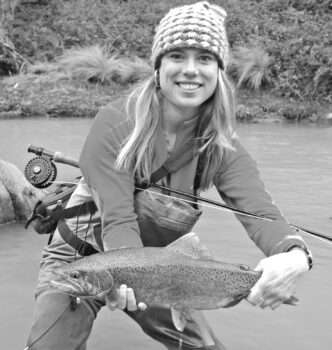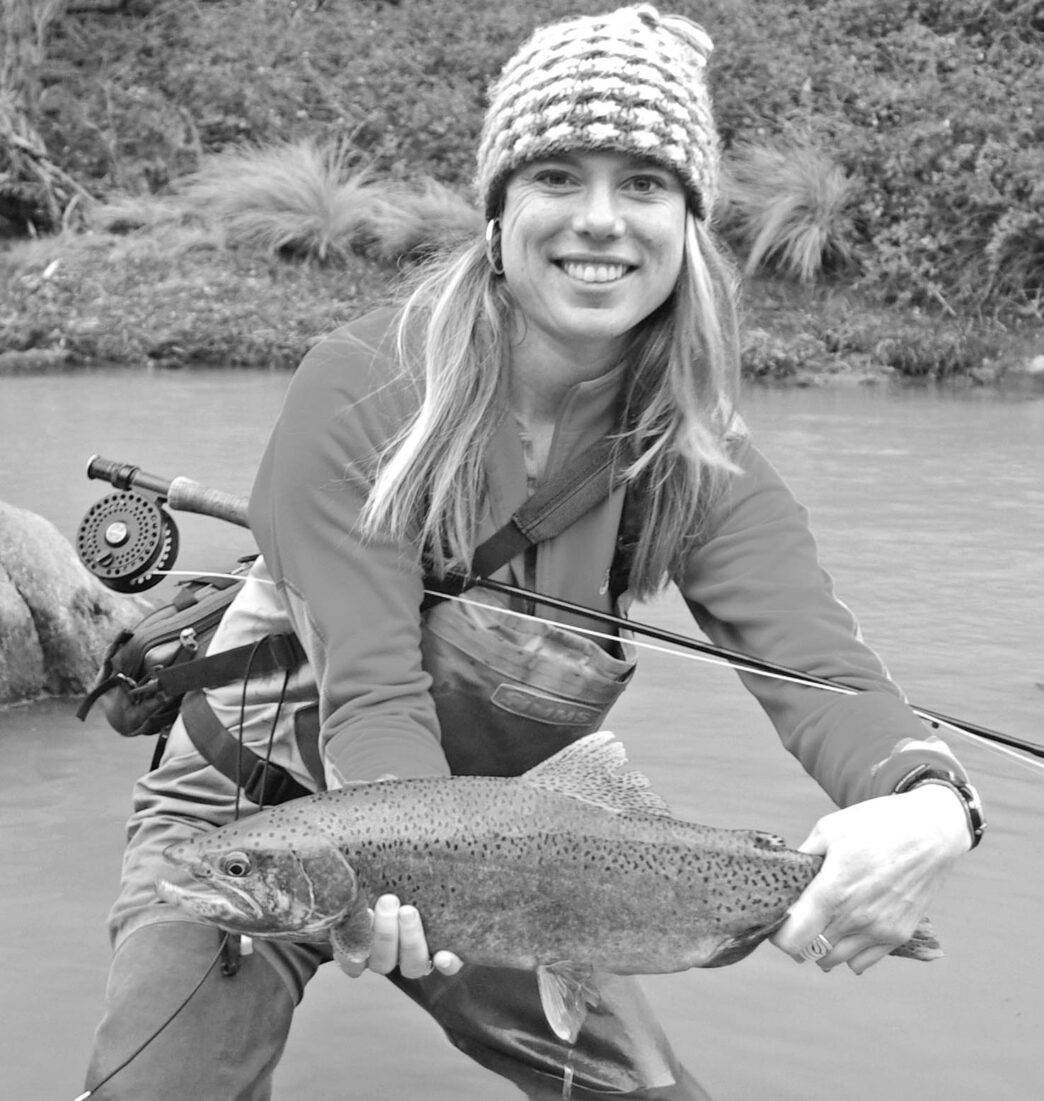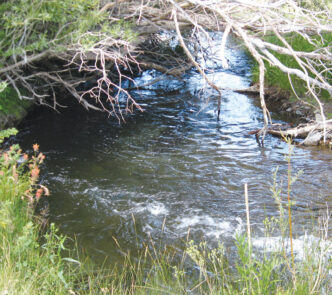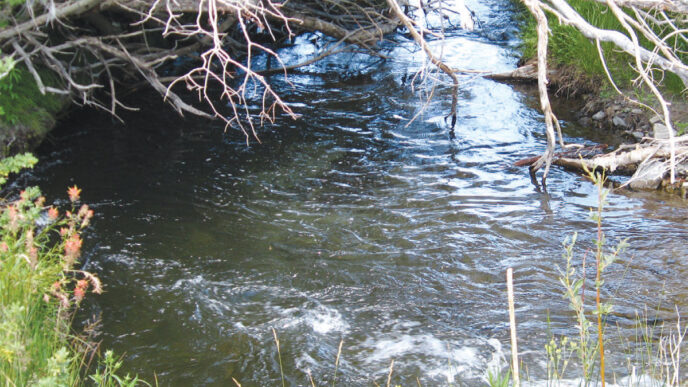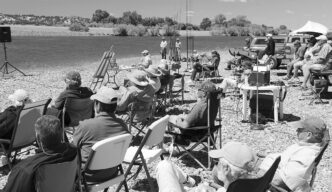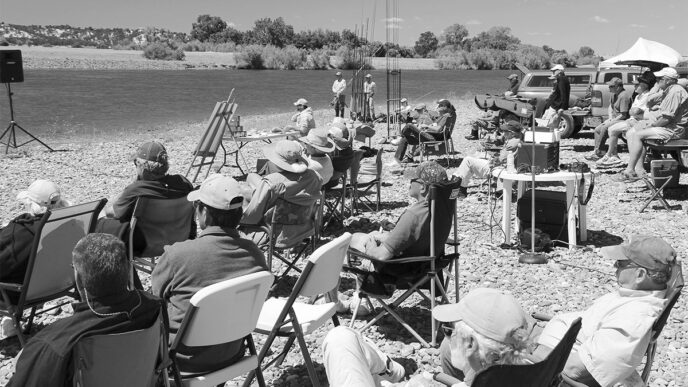Forty-two years ago, only a very select number of fly fishers appreciated California’s wild trout and their capacity for providing excellent sport. For nearly all anglers, whether fish were hatchery-raised or wild was unimportant, catch and keep was the practice of the day, and the general public likely couldn’t tell a trout from a tuna.
Fast forward to 2013, with the dramatic increase in the number California’s fly-fishing anglers, most of whom are practitioners of catch and release. The public’s fascination with trout is unparalleled in the state’s history, with thousands visiting fish hatcheries and attending fish-oriented wildlife festivals every year.
How did this change in awareness of the value of wild trout happen? In part, it is the result of advocacy work by fisheries-conservation pioneers such as Trout Unlimited, California Trout, and the Federation of Fly Fishers. Their efforts have given wild trout equal standing with hatchery-raised fish in the state legislature and at what is now the California Department of Fish and Wildlife.
Building on years of protecting and enhancing wild trout fisheries, the department has expanded its work with its Heritage and Wild Trout Program. The program is coordinated by Stephanie Mehalick, an ardent fly fisher who has worked on the program for six years. California Fly Fisher editor at large Tom Martens visited with her for a chat about the current program and its future.
Martens: Let’s get to the most important issue first. You fly fish — right?
Mehalick: Absolutely. Part of my passion for wild trout comes from my love of fishing and the outdoors. I am not originally from California, but what drew me here is the unique fishing opportunity we have.
Martens: What is your role in the Heritage and Wild Trout Program?
Mehalick: I work hand in hand with our program leader, Roger Bloom, at the statewide level. In part, I oversee our statewide field activities. I have the great pleasure of being able to survey, manage, and protect the unique trout fisheries that our state has to offer, some of which are found nowhere else in the world. In this, I see myself as a steward of wild trout in California, and a large part of my job is promoting this passion to others, whether it be anglers, children, or the general public. I also work on trout policy, management, and regulations.
Martens: How many full-time staff work on the program?
Mehalick: Currently, our program has 12 permanent staff members, some of whom are regional experts in a particular area of the state, and others oversee statewide issues and policy. For instance, here in Sacramento, we have two staff members dedicated to protecting and restoring heritage trout that are threatened or at risk.
Martens: How has California’s management of wild trout evolved over the past four decades?
Mehalick: When the California Fish and Game Commission first established the Wild Trout Program in the early 1970s, the focus was on finding waters that provide quality angling opportunities for wild trout. That part has never changed. It is still a main component of our mission, but we have shifted to integrate more native trout conservation and recovery. As we speak, we have a field crew out collecting fisheries and habitat information for Little Kern golden trout, a threatened species under the federal Endangered Species Act. We are also working on developing a basin-wide monitoring strategy for California golden trout, which is our state freshwater fish.
Martens: My impression is that there was a shift in emphasis from catch-and-release angling to Wild Trout Waters. Why the change?
Mehalick: First off, catch-and-release fishing implies a management direction, and this was confusing to anglers, because these waters could have a zero, two, or even three-fish bag limit. Using the name “Wild Trout Waters” shifted the focus to managing the waters for their intrinsic value and fishing opportunities and then choosing the appropriate sport-fishing regulations to manage them as self-sustaining fisheries. It is a common misperception that Wild Trout Waters must be catch-and-release waters, and that is not the case.
Martens: So not all designated waters have zero limits with gear restrictions?
Mehalick: Not at all. People can eat wild trout, too, and in fact, taking fish is allowed on some of our Heritage Trout Waters. We regularly evaluate population trends, angler use and sport-fishing regulations to ensure that a wild-trout fishery is sustainable. And if changes need to be made, whether regulatory or through habitat enhancement, we consider all options.
Martens: What’s the difference between a wild trout and a heritage trout?
Mehalick: A wild trout must not only live in the wild, but also have been born in the wild, regardless of the origin of its parents or ancestors. A hatchery trout will never be considered wild, even if it survives many years after being stocked. However, if it reproduces in the stream or lake where it was stocked, its offspring would be considered wild trout. Heritage trout are native to California, and we use the term to promote the cultural and natural resource they represent to the state.
Martens: How many streams and lakes in California have received the Wild Trout designation? The Heritage Trout designation? Is a Heritage Trout Water necessarily a Wild Trout Water?
Mehalick: Currently, our program manages 45 designated Wild Trout Waters, 10 of which are also Heritage Trout Waters. These are a subset of Wild Trout Waters and highlight wild populations of California’s native trout found within their native drainages.
Martens: How might an angler determine the location of these waters?
Mehalick: A list of designated waters and associated maps are on the department’s Web page at http://www.dfg.ca.gov/fish/Resources/WildTrout/Waters/.
Martens: What are some of the things the CDFW looks for when designating Wild Trout Waters?
Mehalick: Everyone has different expectations when fishing, whether it is a family event, a chance to catch a big fish, or just some time to get away and enjoy nature. Our constituents are anglers, and we aim to manage waters across the entire state that provide opportunities for everyone. Some things we look for, well, I love going where the action is, even if that means the trout are small, so fast action is definitely one of them. We define fast-action fisheries as waters where the average angler can expect to catch two fish or more per hour. Or there are trophy trout fisheries where an angler has a reasonable chance of catching a trout 18 inches or greater in length. Other considerations include native trout fishing opportunities, roadside versus remote areas, and where in the state it is located. We try to diversify and spread out opportunities as best as possible.
Martens: What’s the process for designating a Wild Trout water?
Mehalick: The designation process takes many years, starting with field crews gathering information on the fishery, habitat, and angler use. In order to understand trends in the trout population, this one component typically takes numerous years. The California Fish and Game Commission is the deciding body on whether waters get designated, but this program is responsible for selecting and recommending new waters each year that we believe meet the qualifications. We are required to recommend a minimum of 25 miles of stream habitat and one lake annually. However, over the last five years, nearly 400 miles have been designated in what we call a watershed-level approach. The end goal is to provide anglers with wild-trout fishing opportunities. Once designated, a management plan is written, and we monitor the fishery to maintain a self-sustaining wild trout angling opportunity for the public. Hat Creek is a great example of a flagship water that was one of the first to be designated in the program, and even though that occurred nearly 40 years ago, to this day, we continue to monitor it at regular intervals and are engaged in an active restoration project. This restoration project is a good example of us working collaboratively with our constituents and with organizations such as Cal Trout that strive to protect and enhance wild trout fisheries.
Martens: Is there a role for fly fishers and fly-fishing clubs to play in identifying waters that might be suitable for inclusion in the Heritage and Wild Trout Program?
Mehalick: Yes, there is a role for anglers in general to provide recommendations, both at an individual and a group level. Bill Carnazzo, who was a local conservationist and fishing guide, not only recommended his favorite water to us for designation, but volunteered time and energy to help us collect data in support of it, and we hope to have the Middle Fork American River’s North Fork designated in the near future. Also, we utilize numerous clubs across the state to help us monitor existing Wild Trout Waters as well as collect new information on candidate waters. Our program staff members are available to give presentations to local fishing clubs, and the topics can include anything from an overview of our program, to local wild-trout fishing opportunities, to ways that clubs can get involved and volunteer.
Martens: Has the California Department of Fish and Wildlife ever considered removing waters from the Heritage and Wild Trout Program? If it has, what typically might be the reasons for doing so?
Mehalick: Yes, as a matter of fact, the Merced River was removed last year, following our recommendation to do so to the Fish and Game Commission. Again, they are the ruling body on whether waters are designated or not, but when a water is designated, it is our responsibility to prescribe management directives and to monitor it. Following a large flood that altered habitat, we were monitoring the wild trout fishery and angler use on the Merced for many years. Our data showed a low population density of wild trout, limited spawning habitat and recruitment of yearling trout, poor catch rates, and poor angler satisfaction. We believed it was no longer providing a quality wild-trout fishing opportunity, and we considered a variety of options, including habitat restoration, while also polling anglers who use this resource. We began talking to local fishing clubs, and in the end, we decided to propose it for removal from the program.
By commission policy, if a water is removed, it must be replaced with an additional Wild Trout Water, and we decided it would be fitting to replace it with something close by, just to the south in Fresno County. So we simultaneously recommended designation of the South Fork San Joaquin River and its tributaries at a watershed level. This was adopted by the Commission and now includes over 150 miles of stream habitat and four lakes upstream of Florence Lake that provide anglers with an opportunity to catch four different types of trout. The watershed includes high-alpine golden trout fisheries, fast-action waters, and even trophy-sized brown trout. There are other waters across the state that have been considered for removal that may no longer fit the criteria for a Wild Trout designation, but first, we must analyze trends in the data, carefully weigh all options, conduct public outreach, and find a replacement, ideally, another water located nearby.
Martens: What is the CDFW’s Heritage Trout Challenge?
Mehalick: We challenge anglers to go out and catch six of California’s native trout in their historic drainages. As I mentioned earlier, these are heritage trout. It takes a little research, some road trips, and lots of fishing, but in the end, anglers will have the opportunity to see first-hand a variety of trout habitats and the uniqueness of our native trout forms, if they catch them. As part of the application for the challenge, each trout must be photographed, and as a reward, those who qualify will receive a signed certificate of recognition and a commemorative hat.
Martens: How popular is the Heritage Trout Challenge?
Mehalick: Since the inception of the challenge in 2003, we have signed and delivered nearly 250 certificates to successful anglers. We receive a lot of sincere and heartfelt feedback on how much people cherish these fish, once given the challenge to catch them — so much so that numerous anglers couldn’t stop at the first six. In fact, we added the Master Angler Challenge to recognize those who capture all 11 of California’s native trout forms.
Martens: What’s the best way for anglers to start the challenge?
Mehalick: First off, find a fishing partner. Then grab a trout reference book or get online and start researching the different types of trout and the habitats in which they are found. Our Web site is a great place to start. Once you begin to figure out the watersheds and their juxtaposition in the state, pull out your maps and begin to look for specific waters and ways to get to them. Depending on which species you are tackling, it may be a simple day trip, or maybe you plan a long camping trip to target numerous types. There are no rules when it comes to how long it takes to complete the challenge, whether three days or three years. When in doubt, our program staff members love talking about fish and fishing and are only a phone call or e-mail away.
The Web site address is http://www.dfg.ca.gov/WildTrout. It has a link to staff contacts, listing not only our wild-trout scientists who work in particular regions of the state, but also those of us who work out of Sacramento and oversee at a statewide level. If someone has particular questions about a local water, I recommend contacting regional staff, because they are the experts. As for the challenge, general wild trout fishing, or volunteer opportunities, please contact me at stephanie.mehalick@wildlife.ca.gov
Martens: Are there any notable new developments in the CDFW’s wild-trout management program?
Mehalick: Last September, Senate Bill 1148 was signed by the governor and directed the department to emphasize and enhance native and wild trout management, both through our state hatcheries and through the Heritage and Wild Trout Program. A major stride we have made recently is the creation of a Strategic Trout Management Team to help implement the bill and oversee all things trout, including stocking, wild-trout fisheries, basin-wide planning, and evaluating fishing regulations. We are hoping that within the next few years, we will have a proposal set forth to simplify our special fishing regulations, many of which are trout waters. This simplification process should not only make it easier for the angler to understand and follow regulations, but will also provide a framework and evaluation process to assist with the best management practices. It may open up fishing opportunities across the state. Also, we are developing an online database where some of our wild-trout information will be available to the public.
Martens: What is the relationship of SB1148 to Assembly Bill 7?
Mehalick: AB-7, which was signed in 2006, augmented our program with funds and permanent staff. It also mandated our hatcheries to produce and stock a certain poundage of trout per fishing license sold. SB-1148 revised language in AB-7, changing some hatchery mandates to goals and increasing emphasis on native trout. It facilitates better management, rather than stocking waters based on mandates. We stock based on management goals, biological justification, and angler use.
Martens: Speaking of using data to improve the management of trout waters, a lot of us have seen angler survey boxes beside special-regulation waters, and some of us have even filled out the survey forms. How useful is the information received from these surveys?
Mehalick: Thank you for highlighting these, because they work only when anglers fill out the forms. We currently maintain and monitor angler survey boxes on 67 waters statewide, waters that are either designated or being evaluated for designation in the Wild Trout Program. These forms provide information on the type of fishery, what species anglers are catching, what sizes, their catch rates, and their level of satisfaction with the fishery. It’s another tool in our toolbox to monitor wild-trout waters somewhat remotely, requiring minimal resources and time. Of course, we rely on not only anglers being honest, but on them on filling out the form, even if they didn’t catch anything. We have compared these forms with angler creel surveys and found both to be very similar. Also, we have an ongoing research project evaluating what percentage of anglers fill out the forms. This study will help us better understand how applicable and representative the information we get from the boxes really is.
Martens: Does designation as a Heritage or Wild Trout Water create any notable enforcement issues?
Mehalick: No. Designated waters are not afforded special regulatory protection. We expect anglers to follow the law on all waters, whether designated, stocked, or otherwise.
History of the Wild Trout Program
Here is the timeline on the origin and development of California’s Heritage and Wild Trout Program.
1970s. Using their experience restoring the fishery at Hat Creek as a model, California trout activists advocated creating a state wild trout protection and enhancement program.
1971. The Wild Trout Program was established by the California Fish and Game Commission to protect and enhance quality fisheries sustained by wild strains of trout. Commissioners adopted a policy for wild trout that provides for the designation of “aesthetically pleasing and environmentally productive” streams and lakes to be managed exclusively for wild trout with appropriate regulations so that they are “largely unaffected by the angling process.” The commission directed the California Department of Fish and Game (DFG), the predecessor of the Department of Fish and Wildlife, to study and identify waters that would provide quality wild-trout angling for designation as Wild Trout Waters.
1979. The California legislature passed a law declaring it state policy to establish and maintain wild-trout populations in suitable waters, directing the DFG to create angling regulations to maintain the wild-trout fishery in them, and requiring the DFG to determine which streams or lakes could be managed as wild-trout fisheries. A law required that the commission develop, as part of the Wild Trout Program, catch-and-release fisheries and regulations in lakes and rivers containing trout. It required the department to prepare a list each year of no fewer than 25 miles of stream or stream segments and at least one lake that it deemed suitable for consideration as catch-and-release trout fisheries and to submit this list to the commission. The commission was then required to submit an annual report to the legislature that includes its reasons why any stream or lake the department offered for consideration was or was not included in the program. Throughout the 1970s, 18 waters were so designated.
1984–1990. Federal funds from an excise tax on sport-fishing equipment increased revenue to the DFG to pay for high-mountain lake surveys and additional staffing for the Wild Trout Program, including both permanent biologists and wildtrout field crew to conduct surveys statewide.
1998. The Fish and Game Commission established the Heritage Trout Program by expanding its Wild Trout policy so that streams or lakes featuring one or more of the state’s native trout and meeting other specific criteria may be designated as Heritage Trout Waters, which are a special subset of Wild Trout Waters. Policies for monitoring and management are guided by management plans that identify actions necessary to protect habitat and maintain or enhance native trout populations.
1999. The Fish and Game Commission designated Golden Trout Creek, the Clavey River, Eagle Lake, Heenan Lake, the upper Kern River, and the upper Truckee River as the first Heritage Trout Waters. The program’s name was changed to Heritage and Wild Trout Program.
2003. The California Heritage Trout Challenge was created by the commission to honor anglers who catch any 6 of the state’s 11 forms of native trout. They receive a personalized award for learning about, fishing for, and catching native trout.
2006. With passage of Assembly Bill 7, the legislature required that $2 million from the Hatchery and Inland Fisheries Fund be used for the Heritage and Wild Trout Program. Seven new biologists were hired for the work, one in Sacramento, and the rest in specific regions throughout the state.
2007. A new law changed a Fish and Game Commission mandate from recommending catch-and-release fisheries to instead recommending Wild Trout Waters when it prepares and submits its list of at least 25 miles of stream or stream segments and at one lake suitable for designation.
2012. With another new law, the legislature adopted a major change in state policy, putting greater emphasis on the management of native and wild trout, and directed the department to form the Strategic Trout Management Team and to create regional plans to guide trout management.
2013. The Heritage Trout Challenge by now has made nearly 250 awards for completion of the challenge.
Tom Martens



